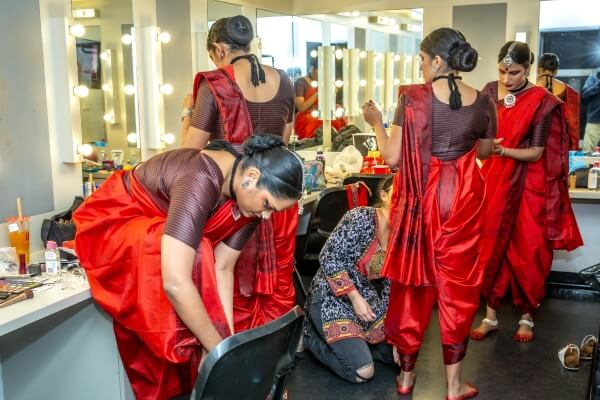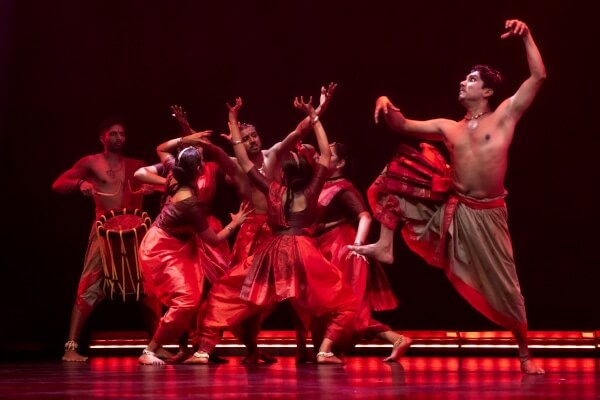Asura Natyam leapt from social media promotions to the NIDA Performing Arts stage with a much anticipated flourish. Debuting to a full auditorium, on 10 August 2024, the team of dancers, musicians and technical crew were met with spellbound gazes and a standing ovation. Directors Seran Sribalan (of Rasana Dance Theatre, Sydney) and Renjith Babu Choorakkad (Saraswatham Foundation and Rtambhara yoga of Chennai) are both leading dancers in the Bharatanatyam space, and their international collaboration has been highly anticipated. The duo were accompanied by Keshavi Jeyaseelan, Shankari Jeyaseelan, Sahana Nandakumar and Durga Shivaji, each of them highly accomplished Sydney-based dancers.
Asura Natyam asks us to explore the ‘grey’ areas of mythology -suggesting that it is our choices that define us, rather than a label that we have been given, i.e. Asura vs Deva. The concept reflects a growing sense amongst the newer generation of South Asians, who respectfully and thoughtfully question the teachings passed down from the elders, in order to try and find meaning that is relevant to their contemporary lives.
The show starts with chaos, and reimagines a time when Asuras were spiritual and divine beings, who ruled over the primordial, undifferentiated energy of the universe. Over time, Asuras came to represent evil, and Devas came to represent dharma (loosely, ‘virtue’). We see the traditional stories that shape this split from a unique lens.

Why is the distraught Hiranyakashipu so vilified for seeking revenge from Lord Vishnu, who killed his brother?
Why we do we glorify Vamana, who tricked the most venerated and beloved Asura King Mahabali into giving up his Kingdom and life for no clear reason?
Why do we not consider the hypocrisy of how Sita, Soorpanakha and Draupadi were treated, at the hands of men and gods who were supposed to embody the concept of Dharma? Most poignantly, the narrator asks, “Why is the subservient woman labelled as a goddess and the rebellious one a raakshasi?”
Two notable mentions in amongst a flawless and thought provoking show: the dragon Vritta fighting Indra and being slayed, and the disrobing of Draupadi. Durga Shivaji (as Draupadi) broke the fourth wall and narrated her disgust at the inaction of her husbands evocatively to the audience in English, but it was her flawless abhinaya which conveyed the depth of her feelings so poignantly.
The cast came together to form an imposing Dragon on stage which moved as one creature. The concept and execution were novel and refreshingly unpredictable. Elements of yoga and martial arts (Kalaripayattu) define the choreography – the physicality and strength of the dancers was palpable from the audience. The fight scenes were visceral yet simultaneously polished and graceful, overall very thrilling to watch.

Spoken word narration by Senthuuran Thevarajah tied the stories and the dancers together. The skill he demonstrated in poetically narrating in both Tamil and English, whilst moving fluidly through the dancers and playing the Parai drum without missing a beat, was exemplary.
Pallavarajan Nagendran (Mridangam) directed the novel musical score. Highlights included the use of overlapping and deliberately dysrhythmic jathi recitations and violins played in minor keys to convey the chaos and distress of the characters on stage. The 16-piece orchestra was incredible to experience, and showcased a mix of junior and senior talented Carnatic musicians. (We recommend you head over to Rasana Dance Theatre’s Instagram handle (@rasanadancetheatre) to learn about these incredible artists in more detail.)
Flawless control of the lighting by Sneha Rao, with clever use of hues of red, helped immerse the audience in this primordial and mythological world.
Seran hopes to be able to take Asura Natyam across Australia and beyond, to enthral more audiences with this visual masterpiece.
READ ALSO: A chat with Bharatanatyam dancer Christopher Guruswamy






